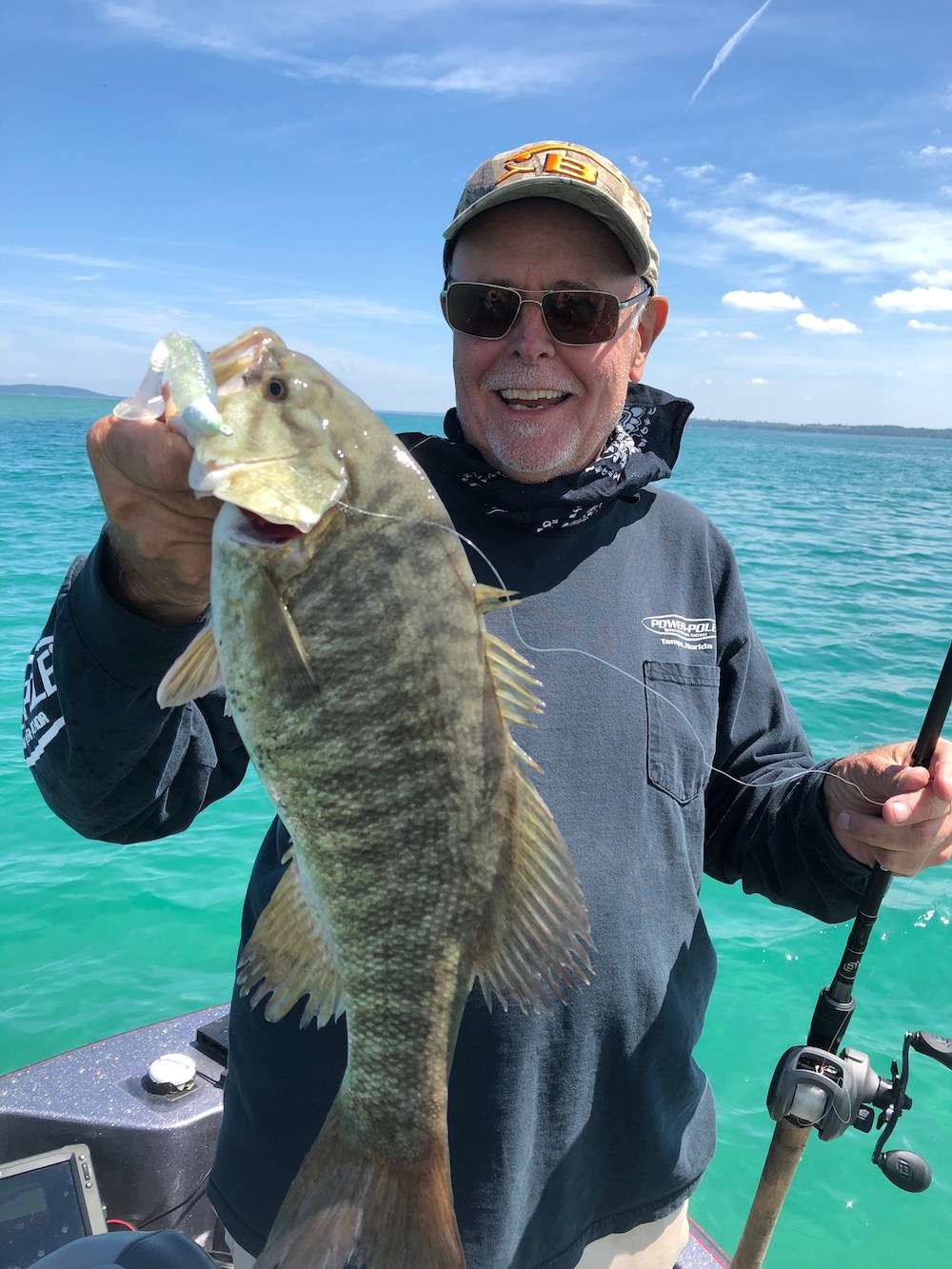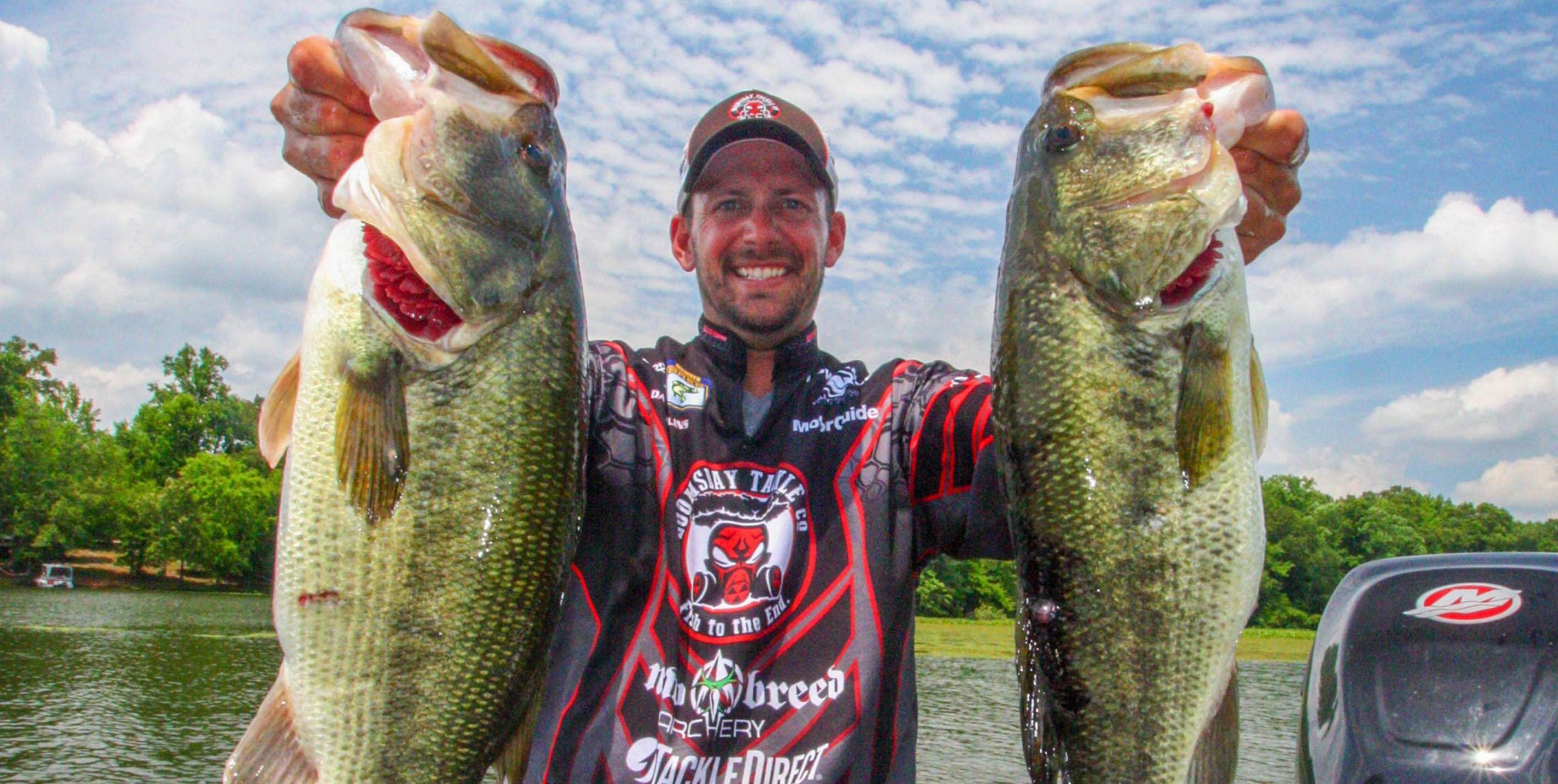
A crazy spring can make for unpredictable early summer fishing. Unseasonably cool temps can modify traditional bass movements. Just because it’s June doesn’t mean bass have moved offshore. Remember, fish don’t use calendars. Elite Series pro David Mullins proves this idea and puts an exclamation point on it with his shallow-water success during his seven-hour test to find and locate fish on a lake he’s never set eyes on before.
If you have struggled to put together a pattern this month, take good notes. Bait selection, depth range and a variety of cover and structure will hold bass. Like Mullins, keep an open mind and your livewell may overflow.
6:29 a.m. Lake R is dead calm when we pull into its deserted launch ramp. Mullins, fresh from his victory at the 2016 Bass Pro Shops Bassmaster Southern Open tournament on Douglas Lake, Tennessee (his home waters), preps the Triton for launching. “I finished second at two previous Southern Opens on Douglas, so it was sweet to finally win one!” he says. “I caught all my bass on deep offshore structure, and I’m curious to see if the fish here will be on a similar pattern. This region has had an unusual spring; it stayed cool for a long time, suddenly got real hot, then cooled off again. The fish here might not be set up on their summer pattern like they were at Douglas.”
7 HOURS LEFT
6:40 a.m. We launch the Triton. Mullins evaluates the water. “It’s 80 degrees with just enough stain so you could fish anything from a jig to a jerkbait. I’m seeing shad breaking the surface everywhere, which is a good sign. I want to try some topwater first thing, then I’ll idle around and see if I can spot anything interesting offshore with my electronics.”
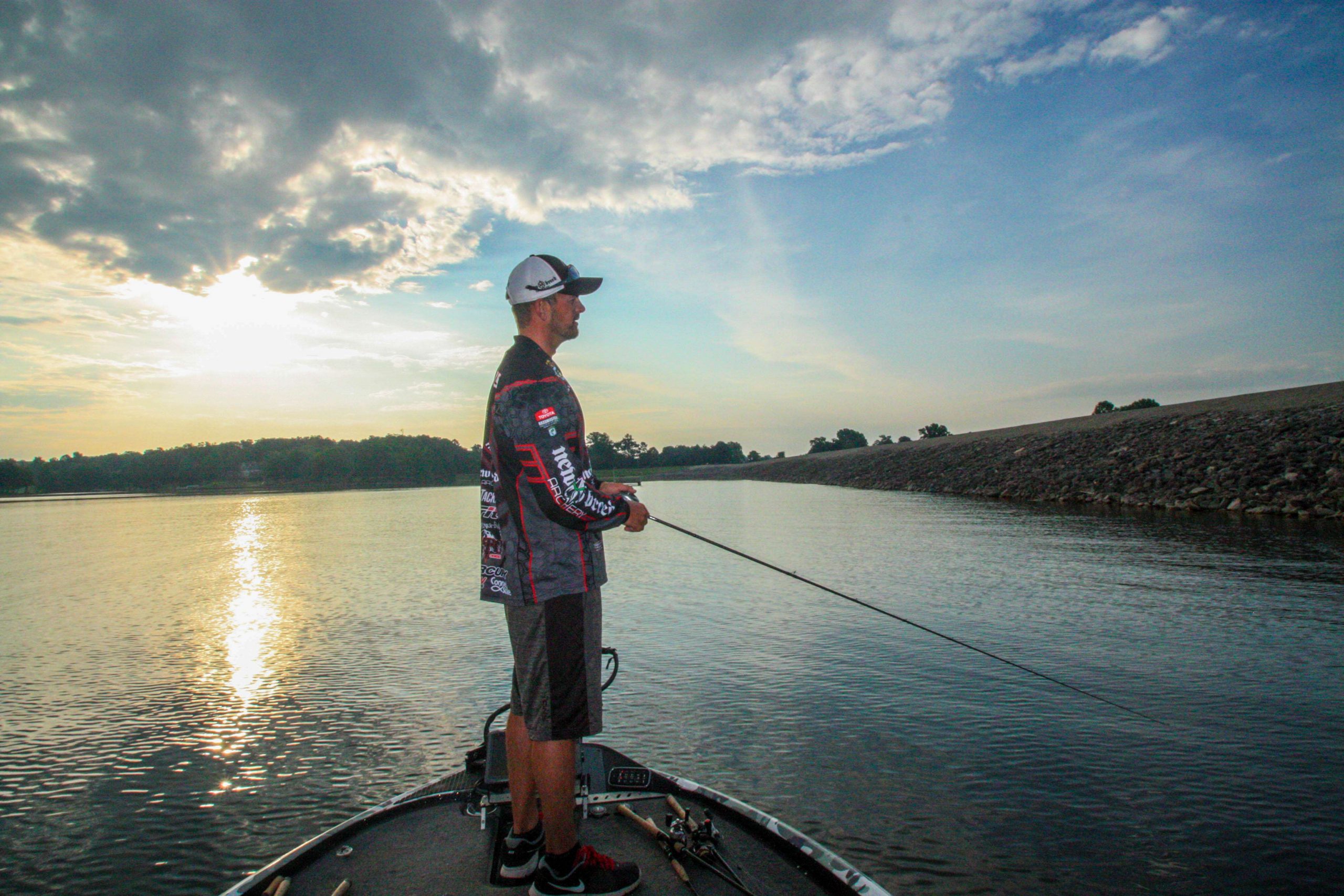
6:49 a.m. Mullins runs to Lake R’s dam, where he dog-walks a Heddon Super Spook stickbait parallel to riprap. The cigar-shaped plug has been pimped with rattles, a feathered tail hook and a custom frog paint job.
6:53 a.m. Mullins casts the Spook to the bank; it lands in an old minnow bucket. “Three points!”
7:04 a.m. Mullins is moving rapidly along the dam with the stickbait. “I’d like to whack a big fish early on top, but all those shad I was seeing have disappeared.”
7:09 a.m. He idles to the mouth of a nearby cove and chunks the Spook around a stone retaining wall.
7:13 a.m. Having abandoned the topwater approach, Mullins cranks the Merc and begins idling around Lake R’s lower end while watching multiple screens on his console graph. “This time of year, I’m looking for fast dropoffs, anything that sticks way up off the bottom, sunken roadbeds, that sort of thing. I’ve split the graph screen to show both down and side views.”
7:21 a.m. Mullins stops at a submerged rockpile four cast-lengths off the bank. “This spot is 8 feet on top with 24-foot water close by. I’m seeing a few fish, probably bass, suspending off the side of the break.” He casts a 6-inch Scottsboro Tackle swimbait on a 3/4-ounce head to the structure and retrieves it slowly.
7:24 a.m. Mullins switches to a redbug 9-inch Zoom Mag II ribbontail worm, Texas rigged with a 4/0 hook and 3/8-ounce sinker. He hops the worm across the rockpile. No takers, so he pulls up his trolling motor. “They’ll normally either hit right away on these offshore spots or not at all, so I’m going to keep moving around and looking.”
6 HOURS LEFT
7:40 a.m. Still idling and graphing. A dark cloud has moved overhead, and it’s sprinkling rain.
7:43 a.m. His graph’s side-image screen shows several tires on the bottom. “Good catfish cover! Bass, too.”
7:50 a.m. The rain has stopped. Mullins locates a submerged hump surrounded by 18 feet of water; it’s 9 feet on top with scattered stumps. He casts the worm to the structure; a bass hits it while it’s sinking, jumps and comes unbuttoned. “That looked like a 2 1/2-pounder. It almost jerked the rod out of my hands!”
7:52 a.m. The worm hangs in some brush; Mullins shakes it free. “A little scattered cover on these offshore places is a huge bass magnet. I don’t like too much cover on them, however; you hang up too often and spook the fish while trying to get your lure back.”
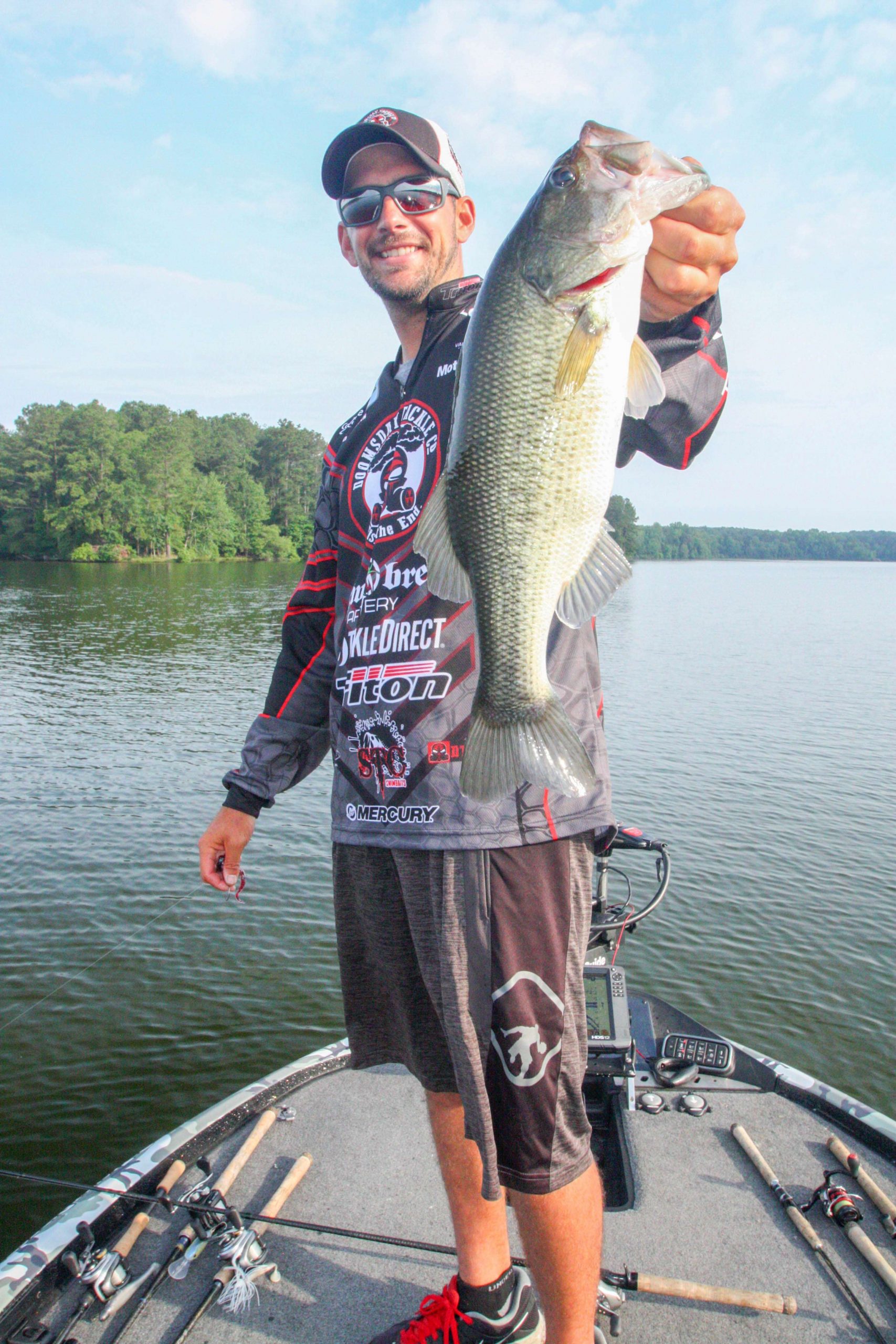
7:55 a.m. Mullins bags his first keeper bass of the day, 2 pounds, 3 ounces, on the Zoom worm. “He was right on top of the hump.”
8:03 a.m. Mullins opts to try a sexy blueback herring Strike King 6XD crankbait on the hump. “I threw this plug a lot last week at Douglas where the bass were 30 feet deep; it’ll easily run 20 feet, which is probably overkill for this spot.”
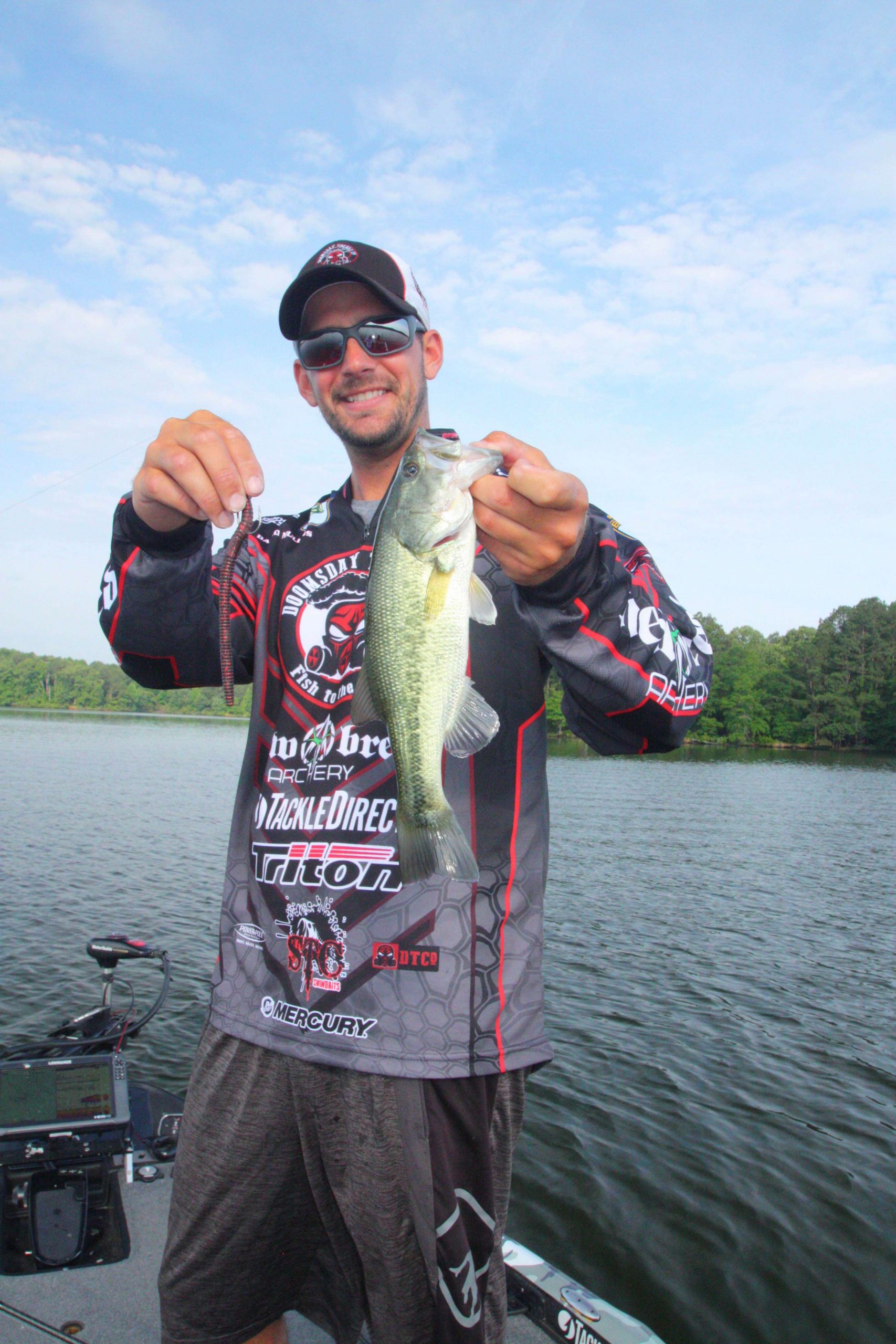
8:04 a.m. He pauses to Texas rig a dirty bluegill Doomsday Roku 7.2 stickworm. “I’ve been working with Doomsday [doomsdaytackle.com] on several prototype lures; this one is a heavily salted sinking worm that’s ideal for dragging deep structure.”
8:12 a.m. Mullins catches his second keeper, 1 pound even, off the hump on the Roku. “This was one of three fish I marked on the same stump.”
8:25 a.m. Mullins hangs the 6XD in some deep brush and breaks it off. “I knew better than to throw that bait there, but I just couldn’t stand it!”
5 HOURS LEFT
8:40 a.m. Mullins has vacated the hump and moved uplake to a long tributary arm, where the water is murkier. He idles around this area for several minutes but doesn’t see any structural features to his liking on his electronics.
8:48 a.m. Mullins makes a high-speed run farther uplake and locates a long point peppered with stumps. He idles around the structure for several minutes. “This point is what I call a ‘razorback’; it’s narrow on top and drops off quickly on either side. I’m not seeing much activity on it right now, but I’ll definitely check it again later.”
8:54 a.m. Mullins spots some shoreline grass at the entrance to a nearby cove. He casts the Super Spook around the cover.
8:59 a.m. The cove sports some juicy-looking pad cover, which Mullins decides to probe with a Tennessee shad Doomsday Laggin’ Dragon 5.4, a prototype soft jerkbait. “This cool bait combines a fat worm body with a slender, blunt finesse worm tail. Rigged weightless on a wide gap hook, it’s incredibly weedless. You can cover a big expanse of pads considerably faster with this bait than with a frog.” He casts the lure to the pads and reels it quickly across the cover.
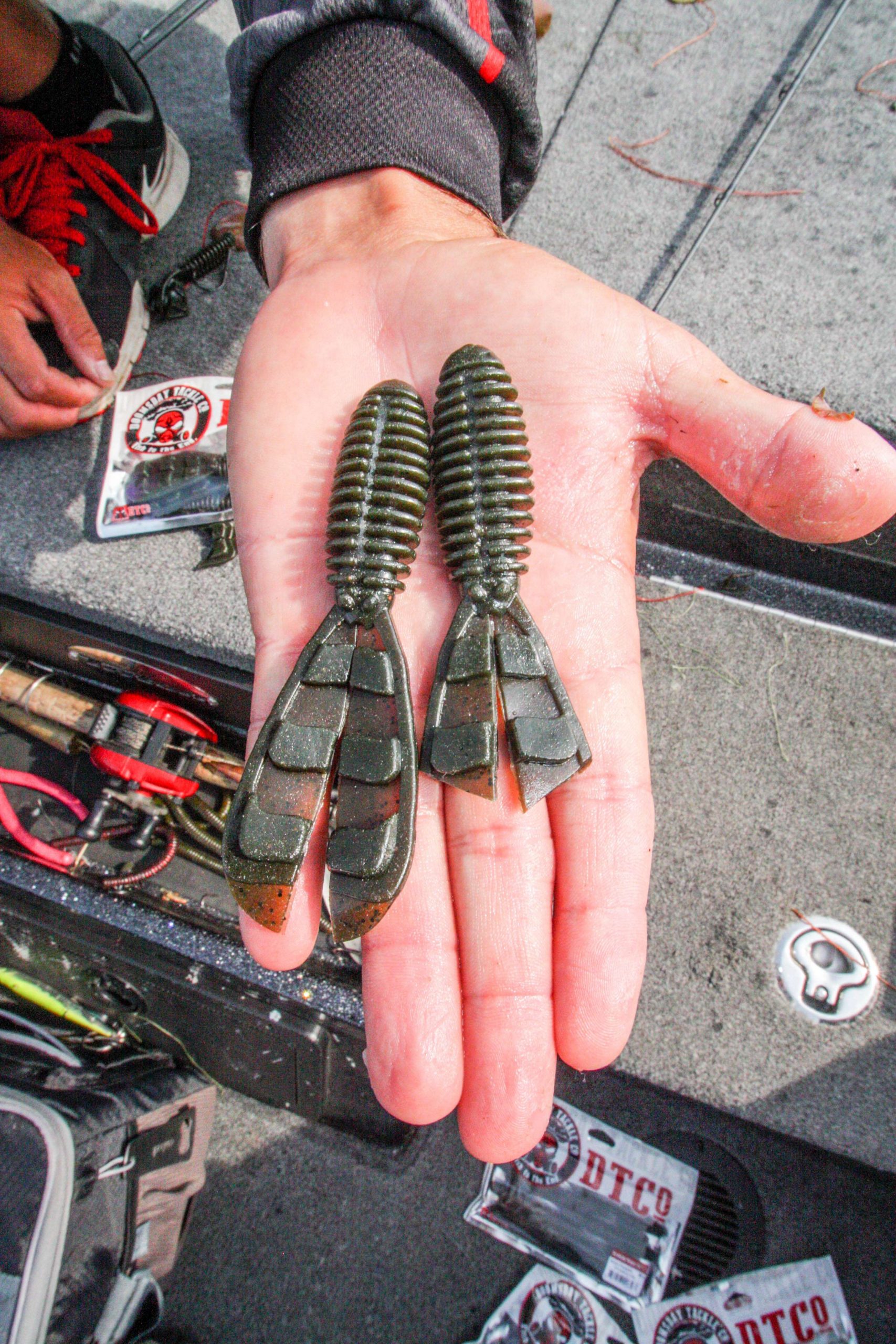
9:04 a.m. Mullins Texas rigs a green pumpkin Doomsday FatMan 4.6 creature on a 5/0 hook with a 1-ounce pegged sinker. “I want to flip these pads for a while, and the FatMan is a killer flippin’ bait. It’s specifically designed to be easy for bass to detect in thick cover or muddy water using only their lateral lines. I’ve trimmed the lure’s claws back a little so it can slide between the pads more easily.”
9:07 a.m. Mullins begins flipping the FatMan to the pads. “I’m just letting it drop straight down, shaking the rod tip a couple times to activate the bait, then picking it up and repeating this process. If you drop it near a fish, it’ll usually hit it.”
9:15 a.m. Mullins slams back his rod and sticks a big fish in the pads! He swings aboard his third keeper, a hulking 6-pound, 14-ounce largemouth. “I worked the whole midsection of this pad field without getting bit, then I made one flip to the edge of the cover and this big girl nailed it! I was planning to mostly fish offshore today, but that last fish makes me want to stay in these pads for a while!”
9:16 a.m. Mullins flips, swings and misses. “That might have been a bluegill.”
9:23 a.m. Mullins has worked his way deeper into the pads, alternating between the FatMan and Laggin’ Dragon.
9:28 a.m. Mullins’ trolling motor has lost power. He raises it to discover “about 200 yards” of fishing line wrapped around the prop.
9:34 a.m. After clearing the line from the prop, Mullins is back flipping. He drops the bait into pads feathering out toward open water to form a point. “Always look for something different when fishing pads. Holes in the cover, areas where two different sizes of pads occur close together, little isolated pad clumps — these are the kinds of places where bass will hang out in this cover.”
4 HOURS LEFT
9:46 a.m. Something nips the FatMan as it drops through the pads, then drops it. Mullins reels in to discover the creature’s claws have been bitten off. “Must have been a grinnel [bowfin]. Those things have a nasty set of choppers.” He rigs a fresh creature on the hook.
9:50 a.m. “This is a situation where one good bite can either lead you in the right or wrong direction,” Mullins says as he continues flipping the pads. “Now that the sun’s higher and it’s getting hot, bass could be stacking up big time on offshore cover, and when that happens, it’s possible to catch a big fish on nearly every cast. I’ve only caught one fish in an hour of pad fishing, but its size sure makes me want to keep flippin’.”
9:53 a.m. Mullins catches keeper No. 4, 1 pound, 4 ounces, on the FatMan. “I never felt the bite, but I saw the pads shake when the lure was sinking, so I set the hook.”
10:11 a.m. While Mullins flips the pads, he offers his take on the day so far. “I think the weather has been too erratic here for a classic deep summer pattern to be in effect just yet. I’ll flip these pads a while longer, then I’m going back offshore to try to hunt up some big concentrations of bass.”
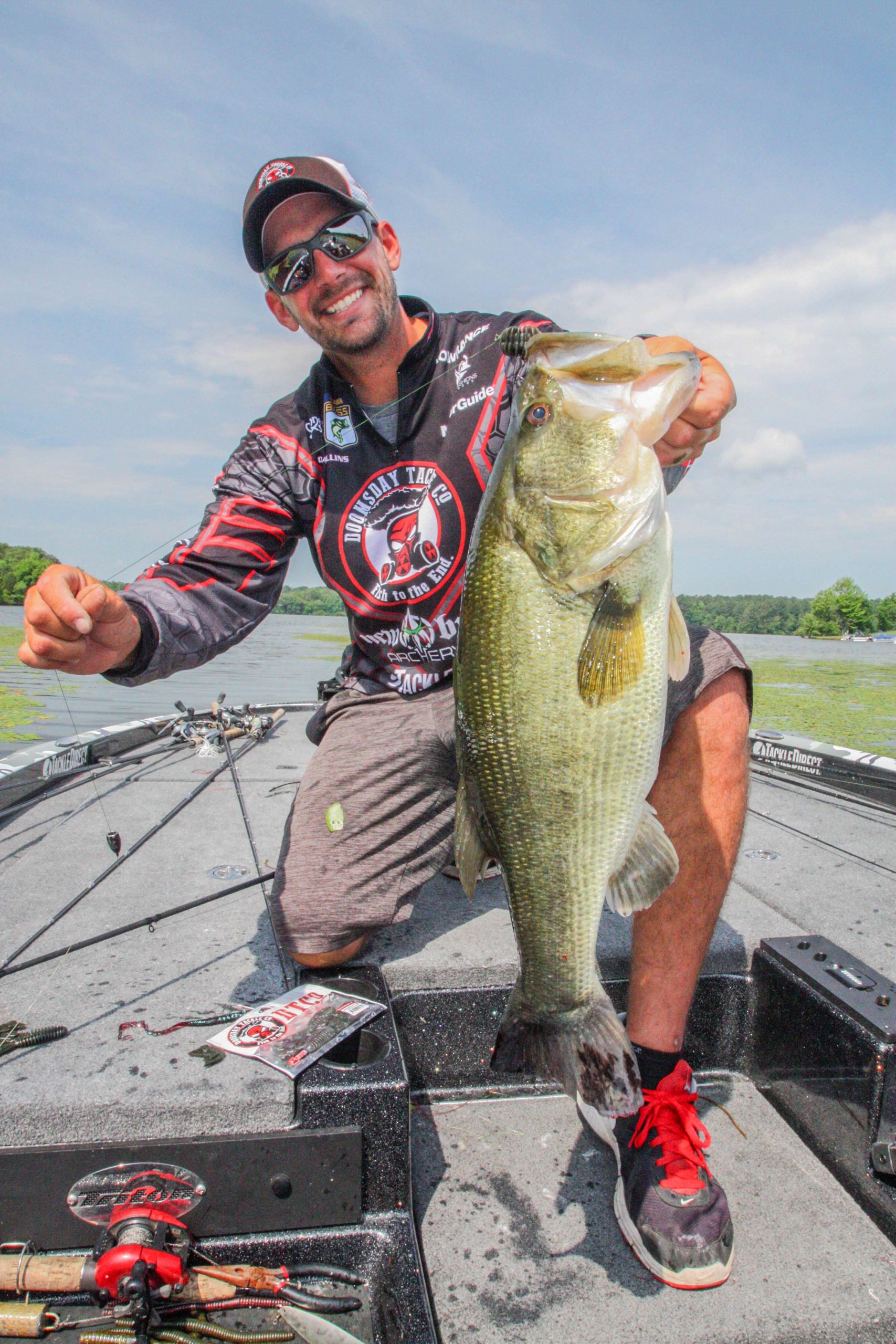
10:18 a.m. Mullins flips the FatMan to the edge of the pads, his line jumps, and he hammers a big fish! He races to the back of the boat to grab his fifth keeper of the day, a spectacular 7-pound, 1-ounce largemouth! “Now, what was I saying about going back offshore?”
10:20 a.m. A local fisherman pulls in right ahead of Mullins, casts a frog into the pads and catches a 4-pounder. “Do you believe that?! I haven’t been cut off that bad in a long time.”
10:31 a.m. Mullins has had a couple of short-strikes on the Laggin’ Dragon while working his way around the cove. “The pads are more broken up in this area. I don’t know if that’s good or bad.”
3 HOURS LEFT
10:46 a.m. He catches a 1-2 on the Laggin’ Dragon; it culls his 1-pounder.
11:04 a.m. Mullins has fished pads across the entire width of the cove and is now on a bank with a mix of pads and laydown wood cover. He tries a white homemade swim jig with a generic shad trailer, retrieving it quickly past the cover.
11:06 a.m. As the swim jig deflects off a moored pontoon boat a 3-pound bass grabs it but shakes loose. “I could have used that one.”
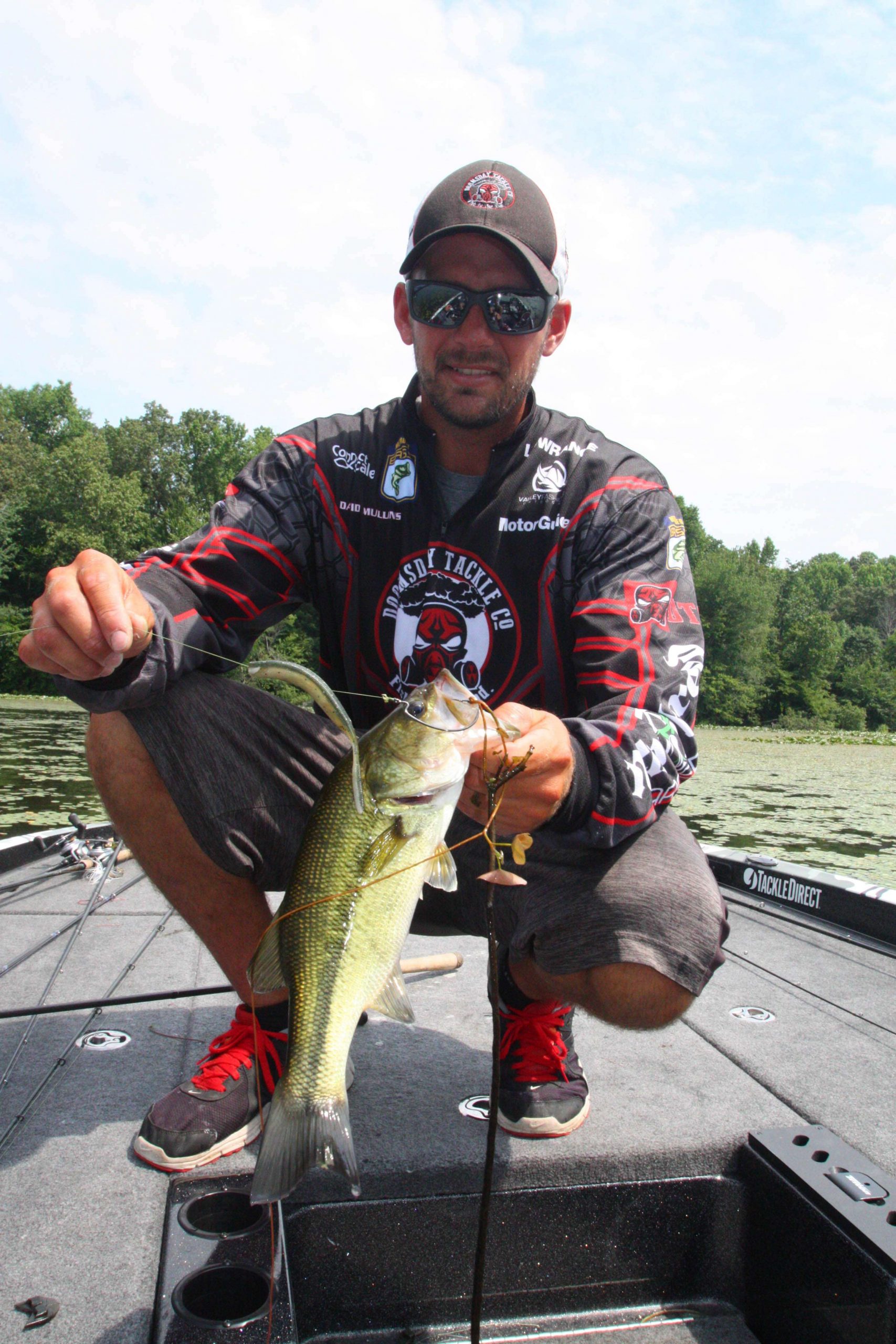
11:15 a.m. Mullins catches his seventh keeper, 1-8, off some isolated pads on the FatMan; it culls the 1-2.
11:23 a.m. Mullins idles to the razorback point he located earlier and tries a Texas rigged green pumpkin Roku worm. The structure is 3 feet deep on top and drops to 13 on both sides.
11:25 a.m. He catches a 1-2 off the point on the Roku; keeper No. 8 is no help.
11:33 a.m. Mullins grinds the 6XD parallel to the side of the point. A 2-pound bass grabs it but comes unhooked.
11:34 a.m. A local pilots his pontoon boat between Mullins and the place where he hooked the 2-pounder. “Well, now that spot is toast!”
2 HOURS LEFT
11:44 a.m. Mullins retrieves the 6XD across the end of the point and hangs it in a stump. He attaches a custom plug knocker, which he’s nicknamed “Elvis,” to this line, lowers it into the unseen obstruction and hangs it up, as well. After considerable tugging, he breaks off both the crankbait and the lure retriever. “Looks like Elvis has left the building!”
11:50 a.m. Mullins ties on another 6XD, this one in Tennessee shad, and resumes cranking the point. Suddenly his rod bows under the weight of a huge fish! “If this is a bass, it’s way bigger than those other two. It feels like it may be foul hooked.”
11:54 a.m. Mullins’ fish turns out to be a 15-pound channel cat. It’s hooked in the tail, and he uses pliers to free his lure.
12:13 p.m. Mullins roars downlake to the hump where he caught his 2 1/2-pounder. He catches a 2-1 largemouth on his first cast with the Roku worm; it culls his 1-4.
12:18 p.m. Mullins runs to the spot where he graphed up several sunken tires. He drags the Roku around the objects.
12:29 p.m. He cranks the 6XD around a main-lake point and dredges up a wad of grass.
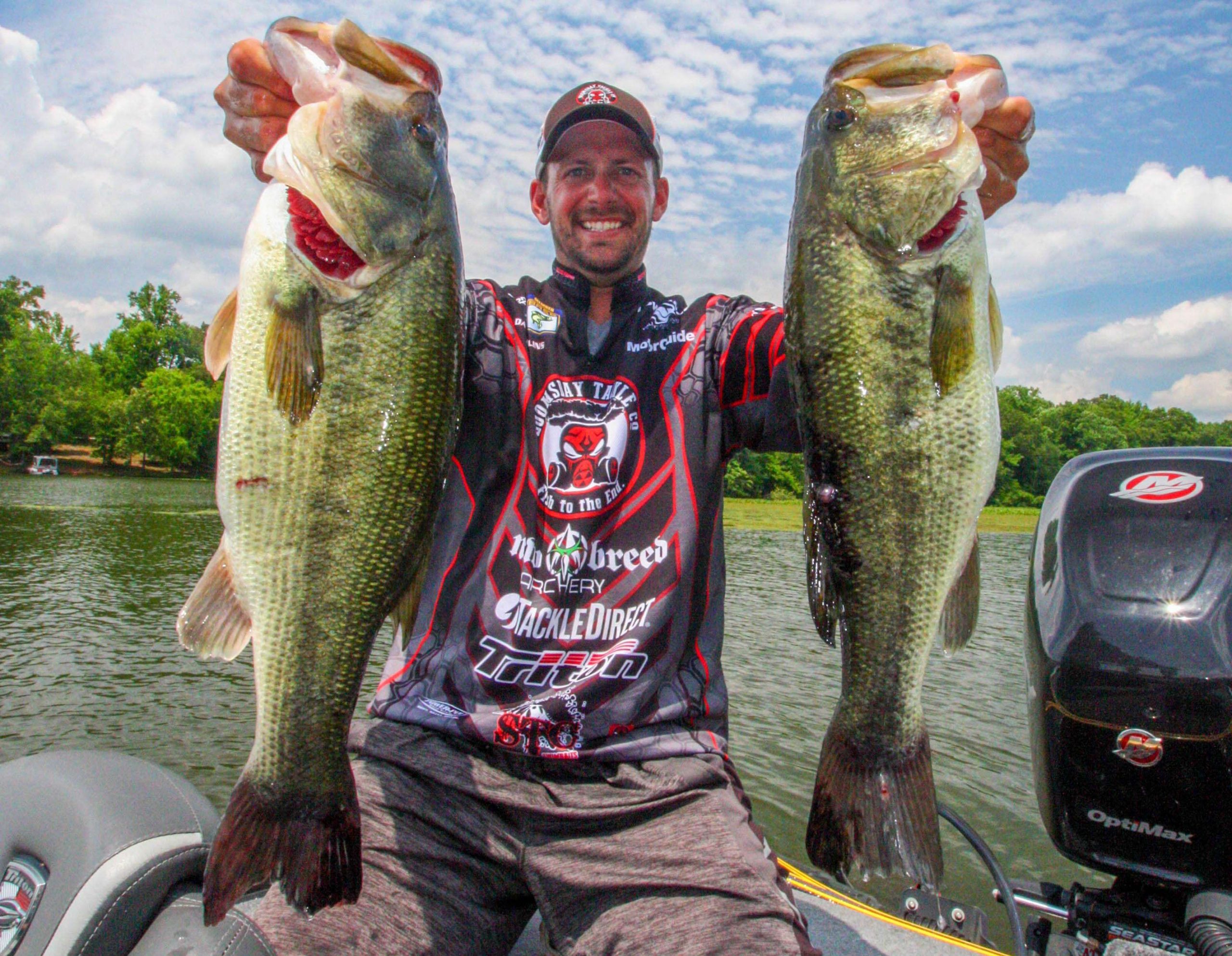
1 HOUR LEFT
12:41 p.m. Mullins has raced downlake to a marina, where he fishes the white swim jig around several boat slips.
12:49 p.m. Mullins moves to a rockpile he fished earlier and drags the Roku around the structure.
1:01 p.m. Mullins races uplake to a shallow pocket clogged with pads. He crawls the soft jerkbait across the cover; a bass blows up on it but misses.
1:07 p.m. Mullins catches a squealer bass on the Laggin’ Dragon.
1:14 p.m. Mullins races uplake to the cove where he caught his two lunkers. “Might as well pound those pads in the time I have left.”
1:22 p.m. He’s back in his glory hole, flipping the FatMan. “A couple more 7s would sure be nice!”
1:33 p.m. After a few more flips to the pads, Mullins’ time is up. He’s had an interesting day on Lake N, boating nine keeper bass; the five biggest total an impressive 19 pounds, 11 ounces.
The Day in Perspective
“The fish in this lake haven’t set up on offshore structure quite yet,” Mullins told Bassmaster. “I caught a few keepers offshore, but the majority of my weight came from two lunkers that I caught flipping lily pads. If I were to fish this lake tomorrow under these same conditions, I’d spend the vast majority of my time flipping pads, then maybe I’d run offshore around 1 p.m. to see if anything other than catfish had moved onto those humps, points and rockpiles I spent too much time on today.”
WHERE AND WHEN DAVID MUILLINS CAUGHT HIS FIVE BIGGEST BASS
1. 2 pounds, 3 ounces; offshore hump; redbug 9-inch Zoom Mag II worm on 4/0 hook with 3/8-ounce sinker; 7:55 a.m.
2. 6 pounds, 14 ounces; lily pads in cove; green pumpkin Doomsday FatMan 4.6 creature on 5/0 hook with 1-ounce sinker; 9:15 a.m.
3. 7 pounds, 1 ounce; same place and lure as No. 2; 10:18 a.m.
4. 1 pound, 8 ounces; lily pads in shallow pocket; same lure as No. 2; 11:15 a.m.
5. 2 pounds, 1 ounce; same place as No. 1; green pumpkin Doomsday Roku 7.2 straight-tail worm on 4/0 hook with 3/8-ounce sinker; 12:13 p.m.
TOTAL: 19 POUNDS, 11 OUNCES

